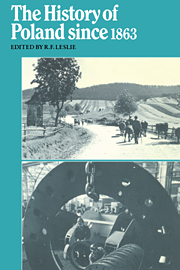Book contents
- Frontmatter
- Contents
- List of maps
- Preface to the paperback edition
- Abbreviations
- Map 1 Poland in the nineteenth century
- 1 Triloyalism and the national revival
- 2 Poland and the crisis of 1900–7
- 3 Poland on the eve of the First World War
- 4 The emergence of an independent Polish state
- 5 The breakdown of parliamentary government
- 6 Piłsudski in power, 1926–35
- 7 Poland without Piłsudski
- 8 Poland in defeat, September 1939–July 1941
- 9 The ill-fated alliance, August 1941–April 1943
- 10 The years of Tempest, May 1943–December 1944
- 11 Post-war Poland
- 12 The rise and ebb of stalinism
- 13 The October turning point
- 14 ‘The little stabilization’
- 15 The decline of Gomułka
- 16 Poland under Gierek
- 17 Polish society, 1945–75
- Epilogue: The rise and fall of Solidarity
- Notes
- Select bibliography
- Index
6 - Piłsudski in power, 1926–35
Published online by Cambridge University Press: 26 December 2009
- Frontmatter
- Contents
- List of maps
- Preface to the paperback edition
- Abbreviations
- Map 1 Poland in the nineteenth century
- 1 Triloyalism and the national revival
- 2 Poland and the crisis of 1900–7
- 3 Poland on the eve of the First World War
- 4 The emergence of an independent Polish state
- 5 The breakdown of parliamentary government
- 6 Piłsudski in power, 1926–35
- 7 Poland without Piłsudski
- 8 Poland in defeat, September 1939–July 1941
- 9 The ill-fated alliance, August 1941–April 1943
- 10 The years of Tempest, May 1943–December 1944
- 11 Post-war Poland
- 12 The rise and ebb of stalinism
- 13 The October turning point
- 14 ‘The little stabilization’
- 15 The decline of Gomułka
- 16 Poland under Gierek
- 17 Polish society, 1945–75
- Epilogue: The rise and fall of Solidarity
- Notes
- Select bibliography
- Index
Summary
‘A government of labour’
Piłsudski came to power with no definite aims. His main interests were in the army and in foreign policy. Though he had strongly criticized the 1921 constitution, he had few clear ideas of what should be put in its place. Indeed, he had only with extreme reluctance decided to order the armed demonstration which had overthrown the Witos cabinet, and the belief that he was a spent force politically had much to do with the decision of the politicians of the Right to set up a new Centre–Right coalition. He was studiously vague about his intentions after the coup, declaring grandly, ‘ My programme is the diminution of robbery and the pursuit of honesty’, and arguing that a strong executive was required to unite the diverse elements in the state. In spite of his former links with the Left, he had no intention of embarking on a radical policy. Poland in his view, as in 1918, was too poor to embark on social experiments. As a result, he resisted demands from the left-wing parties to hold new elections, because they could only return a new parliament strongly conscious of its rights and demanding major social changes. At the same time he criticized the Polish right, which he claimed, unlike the Right elsewhere, was an opponent of a strong executive and lacked political responsibility, as had been shown in the agitation which had preceded Narutowicz's assassination.
Piłsudski still thought of himself as a democrat. After the coup he affirmed that Poles could not be ruled ‘with a whip’, and in August 1926 stressed to one of his associates his ‘intention of still maintaining what is called parliamentarianism.
- Type
- Chapter
- Information
- The History of Poland Since 1863 , pp. 159 - 185Publisher: Cambridge University PressPrint publication year: 1980
- 2
- Cited by



